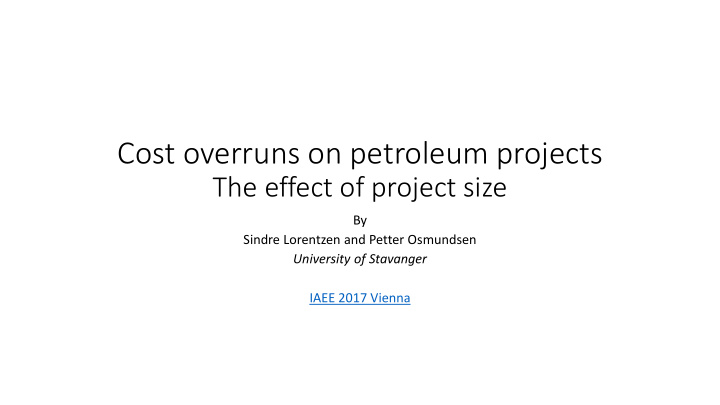



Cost overruns on petroleum projects The effect of project size By Sindre Lorentzen and Petter Osmundsen University of Stavanger IAEE 2017 Vienna
Background • Average cost overruns of 64% on global megaprojects in the oil and gas industry • Ernst & Young (2013) • Project size is the most frequently used explanatory variable • No consensus on the effect • Jørgensen et al., 2012 • Inconsistent results for size • Positive • Dantata et al., 2006; Dahl et al., 2017 • Negative • Creedy, 2006; Hill et al., 2000. • Insignificant • Flyvbjerg et al., 2004; Van Oorshot et al., 2005
Our hypothesis A trade-off between diversification and complexity • Plot contains a negative sloped section, i.e., where increased project size reduces the problem of cost overruns, a flat section, and a positive section where the opposite holds true • The result of a trade-off between several essential cost drivers and modifiers • 1)Diversification. Larger projects can be considered as a portfolio of many small projects. Through diversification, the idiosyncratic risk is reduced or removed in larger projects. This might explain the larger variability in cost realisations for smaller projects and the opposite for large projects. Thus, this is an argument for a decreasing schedule. Dominates initially • 2)Complexity. Project size serves as a proxy for project complexity, which is an argument for larger projects having larger cost overruns, i.e., an increasing schedule. Larger projects rely on critical co-ordination between different subprojects, often manufactured in different countries, thus increasing the probability of overruns. Dominates when size increases
Objective and result • We attempt to shed light on this puzzle by testing for a non-linear relation between cost overruns and project size • When we plot our dataset we find a nonlinear relation between cost overruns and project size • The results of our nonlinear econometric specification conform with the data plot • The findings of the current literature are special cases of our overriding, non-linear approach.
Method • Existing research has been predominantly contained to performing case studies on limited samples • Among studies applying a more empirical approach, the econometric methodology restricted to univariate ordinary least square (OLS) regressions is commonplace • If there is a nonlinear relationship • Samples confined to different segments of project sizes might yield differing results regarding the sign and size of the beta • We address this possibility by applying a multivariable fractional polynomial model, see Royston and Altman (1994)
Multivariate Fractional Polynomial approach • Several multivariate fractional polynomial (MFP) models of degree m with a predefined set of powers are considered: 𝑛 𝜊 𝑘 𝑌 𝑞 𝑘 • 𝜚 𝑛 𝑌; 𝜊, 𝑞 = 𝜊 0 + 𝑘=1 • Box-Tidwell transformations: 𝑌 𝑞 𝑘 = 𝑌 𝑞 𝑘 𝑗𝑔 𝑞 𝑘 ≠ 0 ln 𝑌 𝑗𝑔 𝑞 𝑘 = 0 • Powers: 𝑞 = −2, −1,0, . 5,1,2,3 • Optimal (MFP) model with the best trade-off between explanatory power and parsimony is selected by backward elimination. • Optimal MFP model is compared against a constant term only model and a liner model. Best model is then selected.
Data • 160 oil and gas development projects between 1988 and 2016 on the Norwegian continental shelf • Data sources • The Norwegian Petroleum Directorate • The Investment Committee • Office of the Auditor General of Norway • The Norwegian National Budget
Descriptive statistics Project size (bn NOK) Cost overruns (%)
Descriptive statistics • Positive correlation between cost overruns and project size. • 𝜍 = 0.11 • OLS regression does not yield a statistically significant coefficient.
Results • Model obtained through multivariate fractional polynomial approach: 𝑗 = 𝜊 0 + 𝜊 1 𝑌 −2 + 𝜊𝑌 −2 ln 𝑌 + 𝜁 𝑗 • 𝑍 • Y = Cost overrun • X = realized project size
Results
Results
Results • Linear model with cost overrun on project size does not yield a significant beta-coefficient ( 𝛾 = 0.32 ; p-value = 0.13 ; 𝑆 2 = 0.01 ). • Both coefficients of the obtained MFP model are statistically significant at 1 % level and the MFP model is outperforming a simple linear model. • The results are robust to omission of outliers identified through a leverage versus residual plot. • Results conforms with alternative methods such as nonparametric locally weighted scatter smother regression.
Recommend
More recommend